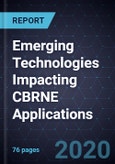Sensors, Drones, Robotics, and Wearables Drive Opportunities in the CBRNE Industry
Opportunities for chemical, biological, radiological, nuclear, and explosive (CBRNE) threat agent detection systems are being largely driven by increasing threats of terrorist attacks.
Chemical threats involve the use of harmful and toxic industrial chemicals or materials and the release of poisonous gases. Biological threats include premeditated attacks by deliberately releasing hazardous bioagents, such as biological toxins. Nuclear and radiological attacks pose an enormous menace and will result in catastrophic losses.
There are also needs and opportunities for improved ability to determine the chemical attribution signature (CAS) of chemical threat agents, trace the origins of toxic chemicals and related materials to their source, and to enhance sample collection and preservation of CAS at the scene.
CBRNE agents cause intense damage that could lead to mass civilian casualties, economic degradation, demolition of critical infrastructure, and contamination of large areas.
Key Questions Answered in the Technology and Innovation Study
- What is the significance of CBRNE technology and its impact?
- What are the current trends and developments that are driving the opportunities for CBRNE technologies in the civilian market?
- What are the technology capabilities of various emerging technologies boosting the CBRNE threat detection?
- Key innovations and their application impact
- IP and Funding scenario
- Growth opportunities and critical success factors
- What sort of strategies do OEMs need to embrace to gain entry and sustain in the competitive marketplace?
Table of Contents
- Strategic Imperatives
- The Strategic Imperative 8™
- The Strategic Imperative 8™
- About the Growth Pipeline Engine™
- Growth Opportunities Fuel the Growth Pipeline Engine™
Chapter 1. - Executive Summary
1.1 Scope of the Technology and Innovation Research
1.2 Research Methodology
1.3 Research Process and Methodology
1.4 Summary of the Key Findings
1.5 Impact of Enabling Technologies in CBRNE Market
Chapter 2. - Technology Landscape - Current State of CBRNE Technology
2.1 CBRNE Technology Landscape - An Overview
2.2 Push for Enhanced Safety Nanotechnology and System Miniaturization are Trending CBRNE Applications
2.3 Enabling Smart Cities and Role of Stretchable Electronics in CBRNE
2.4 Enabling Technologies Empowering CBRNE Applications
2.5 Impact of Drone Technology in CBRNE Applications
2.6 Impact of Robotics, Sensor, and Wearable Technologies in CBRNE Applications
2.7 Global Market opportunities for CBRNE Detection Systems
Chapter 3. - Application Impact Assessment on CBRNE
3.1 Role and Significance of First Responders for CBRNE Detection
3.2 Role of Military Personnel and Civilian in CBRNE Applications
3.3 First Responders Sharing a Common Space in CBRNE Applications
3.4 IFAFRI’s First Responders Capability Gaps
3.5 Potential Solutions for IFAFRI’s First Responders Capability Gaps
3.6 CBRN training networks and EU CBRN Centres of Excellence
3.7 Impact Analysis of Drones in CBRNE Applications
3.8 Impact Analysis of Sensors in CBRNE Applications
3.9 Key Applications of CBRNE Applications
3.10 Impact Analysis of Nanosensors in CBRNE Applications
3.11 Impact Analysis of Terahertz Imaging in CBRNE Applications
3.12 Impact Analysis of Biosensors in CBRNE Applications
3.14 Impact Analysis of Gamma camera in CBRNE Applications
3.15 Significance and Key Developments in SiPR Gamma Detectors
3.16 Impact Analysis of Robotics in CBRNE Applications
3.17 Case Studies of Robotic Solutions for Emergency Operations
3.18 Impact Analysis of Wearable in CBRNE Applications
3.19 Impact Analysis of Software/Simulator in CBRNE Applications
3.20 Key Standards for CBRNE Detection Applications
3.21 Key Standards for First Responder in CBRNE Applications
3.22 Key EU Standards for CBRNE Applications
3.23 Key Government Programs and Initiatives Driving CBRNE Applications
3.24 Key Developments and Initiatives from European Region
3.25 Key EU Projects in CBRNE Application
Chapter 4. - Key Industry Initiative & Stakeholder Ecosystem
4.1 Key Developments in Drones for CBRNE Applications
4.2 Key Developments in Detectors for CBRNE Applications
4.3 Key Developments in Software/Simulators for CBRNE Detection
4.4 Key Developments in Robotics Assisting Emergency Responders
4.5 Key Developments in Sensors Aiding Civilians and First Responders
4.6 Key Developments in Gamma Detectors for Monitoring Radioactive Materials
4.7 Key Developments in Wearable for CBRNE Threat Detections
4.8 Key Developments in EU, Middle East, and APAC Regions
4.9 Key Innovations in Radiation Detection Aiding Civilians
Chapter 5. - Patent Trends and Funding Analysis
5.1 Patent Research Focus Areas are More Toward Development of Sensor Devices
5.2 Funding Trends and Analysis Empowering CBRNE Market
5.3 Key Funding Focus Areas and Initiatives
5.4 Key Funding Focus Areas and Initiatives in EU REGION
Chapter 6. - Growth Opportunities and Strategic Insights
6.1 Growth Opportunities for Enhanced CBRNE Threat Sensing
6.2 Impact of COVID-19 in CBRNE Applications
6.3 Strategic Insights - Critical Success Factors
Chapter 7. - Key Contacts
7.1 Key Contacts







